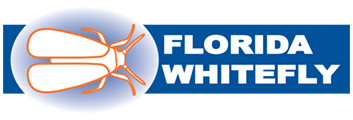Frequently Asked Questions (FAQs)
Whitefly specialists and county extension faculty in Florida commonly encounter a variety of questions pertinent to ficus whitefly, rugose spiraling whitefly, and Bondar's nesting whitefly. Click on the question category below or download all the FAQs as a pdf.
Pest Identification and Plant Damage
Biological Control and Natural Enemies
Pesticide Options
Homeowner Options, Issues and Long Term Effects
Download a PDF of the FAQs page
Pest Identification and Plant Damage
![]() What will whiteflies do to the plants in my yard?
What will whiteflies do to the plants in my yard?
Whiteflies feed on plants through a needle-like mouthpart. The type and level of damage you might see depends upon the species of whitefly and plant. Typical symptoms can include leaf yellowing, leaf wilting, leaf drop, and overall plant decline. Some whiteflies may also produce a white, waxy substance and a sticky substance that can cover parts of the plant.
![]() Will the whiteflies inject a virus into my plants?
Will the whiteflies inject a virus into my plants?
Some whiteflies are known to inject viruses into plants. However, ficus whitefly, Rugose spiraling whitefly and Bondar’s nesting whitefly have not been associated with any known viruses.
![]() Is it just whiteflies that can cause my Ficus benjamina hedge to lose its leaves?
Is it just whiteflies that can cause my Ficus benjamina hedge to lose its leaves?
When ficus is exposed to a rapid change in temperature or other environmental conditions, it will often drop its leaves. Ficus tends to lose its leaves when it is under some sort of stress (e.g. drought, freezing temperatures etc.). Ficus whitefly does cause ficus to drop its leaves, however it takes several months of having a whitefly infestation before this happens.
![]() What is the sticky stuff and does it hurt my plants?
What is the sticky stuff and does it hurt my plants?
Some insects, including whiteflies, will excrete a clear, sticky liquid called “honeydew”. Honeydew does not harm your plants, however, black sooty mold will grow where there is honeydew. Honeydew can be messy and may potentially damage the finish on cars or other painted objects if not washed off.
![]() What is the black stuff and does it hurt my plants?
What is the black stuff and does it hurt my plants?
The black stuff is sooty mold which grows on honeydew produced by some insects. Sooty mold is a fungus but is not a plant disease. However, when your plants are completely covered with sooty mold, it may interfere with photosynthesis which can affect the overall health and growth of a plant. Sooty mold can last a long time but will eventually wear off. Pressure washing is often used to remove sooty mold.
![]() What is the white, fluffy stuff on my plant?
What is the white, fluffy stuff on my plant?
Some insects produce a white flocculent that is made of wax which can vary in appearance from fluffy to stringy. Rugose spiraling whitefly produces a lot of this white substance that can cover the leaves of the plants and surrounding area. It is not harmful to plants or animals. If control of the whiteflies is achieved, this waxy material will go away quickly.
Biological Control and Natural Enemies
![]() Should I use biological control to manage whiteflies in my yard?
Should I use biological control to manage whiteflies in my yard?
The most important thing you can do is not to harm what already exists in your yard. There are many good insects and diseases in your yard that can attack whiteflies. The types and methods of insecticides you choose to use can help keep the good guys there. At this time, buying and releasing the good insects will probably not have much impact. However, scientists with the University of Florida, USDA and Florida Division of Plant Industry are currently looking at several potential natural enemies that include beetles, mites, wasps and disease organisms for the control of whiteflies attacking plants in south Florida.
![]() Should we buy and release ladybugs?
Should we buy and release ladybugs?
At this time, the answer is no but this may change for the future as more information is developed. Ladybird beetles (ladybugs) can be excellent predators for many pests. Although many will eat several types of pests, there still needs to be a match between the predator and the pest. The common ladybug that many people purchase from nurseries or through the mail prefer to feed on aphids. It is called the convergent lady beetle (Hippodamia convergens). In Florida, these beetles will often fly away as soon as they are released. There are a few mites and other insects that attack whiteflies which can be purchased and most have been released in Florida for the management of other types of whiteflies already. There is not enough information right now to know how much impact they might have on the current whitefly problems in south Florida. Commercially available predators and parasites of whiteflies include:
Amblydromalus limonicus - a predatory mite (commonly found in Florida)
Amblyseius swirskii - a predatory mite (commonly released in Florida)
Chrysoperla species – green lacewings (commonly released in Florida)
Delphastus catalinae - a small black ladybird beetle (commonly found in Florida)
Encarsia formosa - a small parasitic wasp (commonly released in Florida)
Eretmocerus eremicus - a small parasitic wasp (commonly released in Florida)
![]() What effects do insecticides have on the natural enemies?
What effects do insecticides have on the natural enemies?
Anything you do to control the whiteflies in your yard can have some negative impact on natural enemies. This is particularly true for many of the insecticides. Many of the insecticides will harm the good insects so it is important to follow the label instructions to use these products in the safest manner possible. Typically, insecticides that have direct contact with the natural enemies (e.g. spraying on the leaves) will have the most negative impact.
![]() Is drenching with the Neonicotinoid insecticides harmful to bees?
Is drenching with the Neonicotinoid insecticides harmful to bees?
Typically, spraying most insecticides on leaves can be harmful to natural enemies due to the direct contact. If a product is toxic to bees, then a foliar spray should not be used on plants when bees are actively pollinating those plants. This includes the neonicotinoids. The neonicotinoids can be applied to the soil or trunk of a tree which reduces direct contact to natural enemies. However, there is potential exposure through pollen to those insects that visit flowers of treated plants. Bees must visit a flower and feed on pollen or nectar in order to be exposed to soil or trunk applied systemic insecticide. Ficus and many other trees impacted by the problematic whiteflies do not flower, or are not pollinated by bees. Neonicotinoids or any other insecticides should only be used when necessary to avoid negatively impacting natural enemies including bees. Many of the insecticides applied to the leaves such as the pyrethroids could have a larger impact on the bee populations than soil or trunk treatment with a neonicotinoid.
![]() What type of insecticide should I use to kill whiteflies in my yard?
What type of insecticide should I use to kill whiteflies in my yard?
Typically applying a systemic insecticide in the neonicotinoid group as a soil or trunk application can provide excellent control. There are numerous options for foliar sprays, however, these types of products often do not last very long and require several repeat applications.
![]() Who can apply the insecticide?
Who can apply the insecticide?
If you are a homeowner, you can purchase and apply any non-restricted use pesticide to plants on your property, but not on those outside your property line. In the State of Florida, anybody who is going to be paid to apply pesticides must have the proper pesticide license. In many counties, the homeowner is also responsible for trees planted in the swale (right-of-way) in front of their property. If the plants are in a homeowner association public area, right-of-way, commercial or industrial area, the property owner needs to hire a pest control company.
Homeowner Options, Issues and Long Term Effects
![]() What can I expect long term?
What can I expect long term?
Often when a new pest arrives and becomes established, it will reach high populations and be at its worst for several years. It will also likely spread to new areas. Typically, after that time, most new pests begin a steady decline. This is in part due to natural controls. Although some insecticide use may be necessary, it is very important to understand the importance of natural enemies and the need to focus on long-term, biologically based management. These pests will likely never go away completely, but should dissipate with time.
![]() What else do I need to do?
What else do I need to do?
When insects feed on plants, it puts the plants under stress. Therefore, proper watering and fertilizing is important to keep the tree as healthy as possible.
![]() Should I apply an insecticide to control whiteflies in my yard?
Should I apply an insecticide to control whiteflies in my yard?
You should never apply an insecticide for whitefly unless you have confirmed that you have a whitefly problem. If no steps are taken, it is unknown what the impact will be of continuous whitefly infestations for several years though the impact will likely depend on the type of plant and whitefly. Choosing to use an insecticide is a personal decision but can be an important step in managing whiteflies. This is particularly true in these situations with new whiteflies when other options for control are still being investigated.
![]() Is my tree going to die?
Is my tree going to die?
Whiteflies do not typically kill large, healthy trees, shrubs and palms. However, very young, newly planted or unhealthy plants are more at risk and could potentially die when they are heavily infested with some types of whiteflies.
![]() Do I need to prune or remove my tree if it is infested with whiteflies?
Do I need to prune or remove my tree if it is infested with whiteflies?
You don’t need to prune or remove your tree. In the vast majority of cases, the tree will survive. However, if a tree is in need of pruning, it is best to remove any branches prior to applying the insecticide and to always follow good arboricultural pruning practices.


